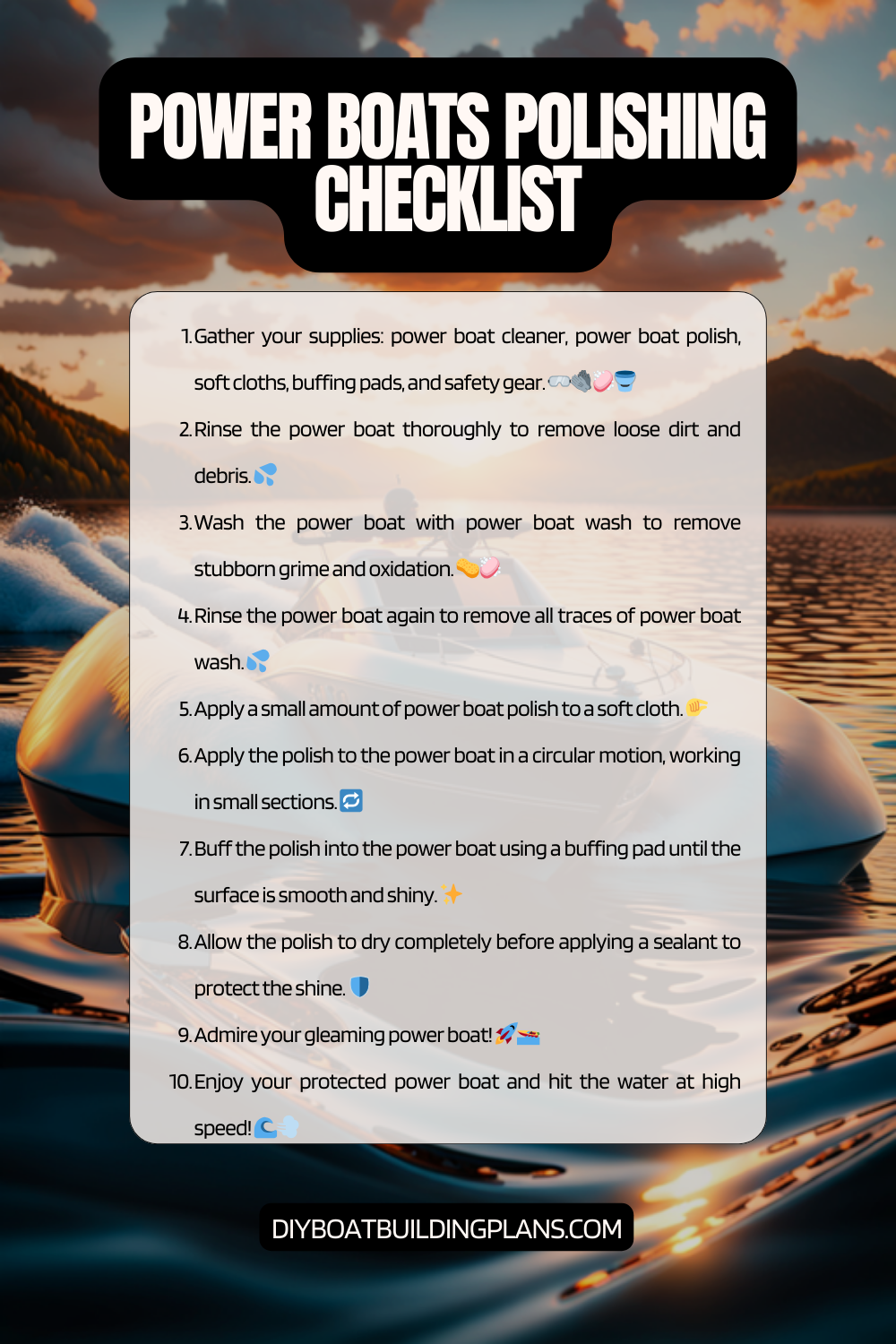Overview of Power Boat Polishing Tips
Power boat polishing refers to the process of restoring and maintaining the shine and appearance of a power boat’s exterior. It involves using specialized products and techniques to remove oxidation, stains, and imperfections from the boat’s surface, leaving it looking clean, glossy, and protected. Maintaining the appearance of your power boat is not just about aesthetics; it also plays a crucial role in preserving the boat’s value and ensuring its longevity.
Key Takeaways
- Regular polishing is important to maintain the appearance and value of your power boat.
- Choose the right polishing products based on the type of surface you are polishing.
- Proper preparation, including cleaning and sanding, is crucial for achieving a smooth and shiny finish.
- Use a step-by-step approach and pay attention to hard-to-reach areas for best results.
- Avoid common mistakes such as using too much pressure or skipping steps in the polishing process.

Importance of Polishing Your Power Boat
Polishing your power boat offers numerous benefits that go beyond just making it look good. Firstly, it helps protect the boat’s surface from environmental factors such as UV rays, saltwater, and pollutants. These elements can cause damage over time, leading to fading, discoloration, and even structural issues. By regularly polishing your power boat, you create a protective barrier that shields it from these harmful elements.
Secondly, polishing helps prevent oxidation, which is a common problem for power boats exposed to water and sunlight. Oxidation occurs when the gelcoat or fiberglass surface breaks down due to exposure to UV rays and other environmental factors. This can result in a dull and chalky appearance. Polishing removes the oxidized layer, revealing the vibrant color and shine underneath.
Choosing the Right Polishing Products
When it comes to choosing the right polishing products for your power boat, there are several options available on the market. These include compounds, polishes, waxes, and sealants. Compounds are abrasive products designed to remove heavy oxidation and scratches. Polishes are less abrasive and are used to restore shine and remove light imperfections. Waxes provide a protective layer that enhances shine and repels water, while sealants offer long-lasting protection against UV rays and other environmental factors.
When selecting a product, consider factors such as the condition of your power boat’s surface, the level of oxidation or imperfections, and the desired level of protection. It’s also important to choose products specifically formulated for use on gelcoat or fiberglass surfaces, as using the wrong product can cause damage.
Preparing Your Power Boat for Polishing
| Task | Frequency | Time Required |
|---|---|---|
| Clean Hull | Before Polishing | 2-3 hours |
| Remove Rust Stains | As Needed | 1-2 hours |
| Apply Compound | Once a Year | 4-6 hours |
| Apply Wax | Twice a Year | 4-6 hours |
| Polish Stainless Steel | As Needed | 1-2 hours |
Before you begin the polishing process, it’s essential to properly prepare your power boat’s surface. Start by thoroughly cleaning the boat to remove any dirt, grime, or salt residue. Use a mild detergent and a soft brush or sponge to avoid scratching the surface. Rinse the boat with clean water and allow it to dry completely.
If there is any existing wax or polish on the surface, it needs to be removed before applying a new layer. This can be done using a wax remover or a specialized gelcoat cleaner. Apply the product according to the manufacturer’s instructions and use a soft cloth or sponge to gently remove the old wax or polish. Ensure that all residue is completely removed before proceeding with the polishing process.
Step-by-Step Guide to Polishing Your Power Boat
1. Applying the polish: Start by applying a small amount of polish onto a clean, soft cloth or applicator pad. Work in small sections, applying the polish in circular motions. Avoid applying too much pressure, as this can cause swirl marks.
2. Buffing the surface: Once the polish has been applied, use a rotary buffer or a dual-action polisher to buff the surface. Move the buffer in overlapping passes, working from one section to another. Keep the buffer moving at all times to avoid overheating and damaging the gelcoat or fiberglass.
3. Removing excess polish: After buffing each section, use a clean microfiber cloth to wipe away any excess polish. This will reveal the shine and ensure an even finish. Repeat these steps until the entire boat has been polished.
Tips for Polishing Hard-to-Reach Areas
Polishing hard-to-reach areas of your power boat can be challenging but not impossible. One option is to use specialized tools such as mini polishers or foam pads designed for tight spaces. These tools allow you to reach corners, edges, and other areas that are difficult to access with a regular buffer.
Another tip is to be patient and careful when working on these areas. Take your time and use gentle pressure to avoid causing any damage. It may also be helpful to break down the polishing process into smaller sections, focusing on one area at a time.
Polishing Fiberglass vs. Gelcoat
Understanding the differences between fiberglass and gelcoat is crucial when it comes to polishing your power boat. Fiberglass refers to the structural material used in the construction of the boat, while gelcoat is the outer layer that provides a smooth and glossy finish.
When polishing fiberglass, it’s important to use products specifically formulated for this material. Fiberglass compounds are typically more abrasive and can effectively remove heavy oxidation and scratches. Follow up with a polish to restore shine and protect the surface.
Gelcoat, on the other hand, requires less abrasive products to avoid damaging the surface. Use a mild polish or cleaner specifically designed for gelcoat surfaces. This will help remove light imperfections and restore the shine without causing any harm.
How Often Should You Polish Your Power Boat?
The frequency of power boat polishing depends on several factors, including the condition of the boat’s surface, how often it is used, and the environmental conditions it is exposed to. As a general guideline, it is recommended to polish your power boat at least once or twice a year.
However, if your boat spends a significant amount of time in saltwater or under intense sunlight, more frequent polishing may be necessary. Regularly inspect your power boat’s surface for signs of oxidation, fading, or imperfections. If you notice any issues, it’s best to address them promptly to prevent further damage.
Maintaining Your Power Boat’s Shine
To maintain the shine and appearance of your power boat, regular cleaning and maintenance are essential. Rinse the boat with fresh water after each use to remove salt and other contaminants. Use a mild detergent and a soft brush or sponge to clean the surface, avoiding abrasive materials that can scratch the gelcoat or fiberglass.
After cleaning, apply a protective wax or sealant to enhance shine and provide a barrier against environmental factors. This will help prolong the life of your power boat’s finish and make future cleaning easier.
Download over 500 Boat Plans. Click on the link below.
-->Click Here<--
Common Polishing Mistakes to Avoid
While power boat polishing can greatly enhance the appearance of your boat, there are some common mistakes that should be avoided. Over-polishing is one such mistake, as excessive buffing can remove too much gelcoat or fiberglass, leading to thinning and weakening of the surface.
Using the wrong products is another mistake to avoid. Always choose products specifically formulated for use on power boats, and follow the manufacturer’s instructions carefully. Using harsh or abrasive products can cause irreversible damage to the surface.
Lastly, not properly preparing the surface before polishing is a common mistake. Failing to remove old wax or polish residue can prevent the new product from adhering properly and achieving the desired results. Take the time to thoroughly clean and prepare the surface before beginning the polishing process.
Power Boat Polishing Checklist

Conclusion – Power Boat Polishing Tips
In conclusion, power boat polishing is an important aspect of maintaining the appearance and value of your boat. By regularly polishing your power boat, you not only enhance its shine but also protect it from environmental factors such as UV rays, saltwater, and pollutants.
When choosing polishing products, consider factors such as the condition of your boat’s surface and the level of protection required. Properly preparing the surface before polishing is crucial for achieving optimal results.
Remember to pay attention to hard-to-reach areas and use specialized tools if necessary. Differentiate between fiberglass and gelcoat surfaces to choose the appropriate products and techniques.
Maintaining your power boat’s shine requires regular cleaning, waxing, and protection from environmental factors. Avoid common polishing mistakes such as over-polishing, using the wrong products, and not properly preparing the surface.
By following these tips and guidelines, you can ensure that your power boat remains in top condition, looking its best for years to come.
FAQs – Power Boat Polishing Tips
What is power boat polishing?
Power boat polishing is the process of removing oxidation, stains, and scratches from the surface of a boat using a power tool and polishing compound to restore its shine and protect it from further damage.
Why is power boat polishing important?
Power boat polishing is important because it helps to maintain the appearance and value of a boat. It also helps to protect the boat from the damaging effects of the sun, saltwater, and other environmental factors.
What tools are needed for power boat polishing?
The tools needed for power boat polishing include a power buffer or polisher, polishing pads, and polishing compound. It is also recommended to have a clean microfiber towel and a spray bottle of water on hand.
What is the best polishing compound to use for power boat polishing?
The best polishing compound to use for power boat polishing depends on the type of boat and the condition of its surface. Some popular options include marine-specific polishing compounds, rubbing compounds, and oxidation removers.
How often should power boat polishing be done?
Power boat polishing should be done as needed, depending on the condition of the boat’s surface. It is recommended to polish the boat at least once a year to maintain its appearance and protect it from damage.
Can power boat polishing be done by a beginner?
Power boat polishing can be done by a beginner, but it is important to follow proper safety precautions and techniques to avoid damaging the boat’s surface. It is also recommended to start with a small area and work in sections to ensure even polishing.



